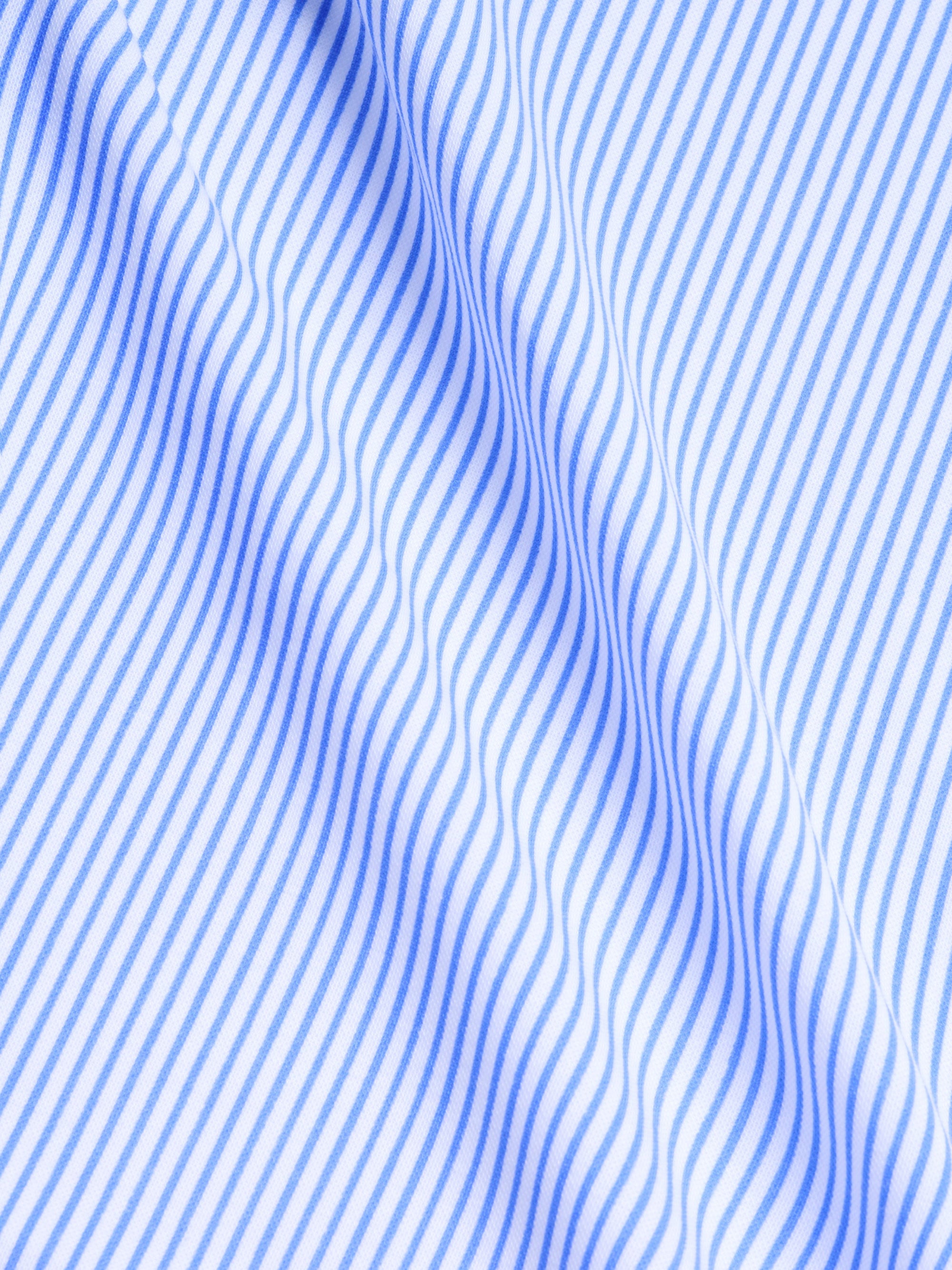Before you ever shake hands or answer your first question, you’re already being sized up. Like it or not, your appearance is part of the interview — and your dress shirt is front and center.
But here’s the catch: dressing “well” doesn’t mean dressing loudly. In fact, the best dress shirt for a job interview is the one that shows you get it. You understand the setting. You respect the role. And you’ve got enough sense to keep your shirt clean, crisp, and on point.
The wrong shirt — too loud, too sloppy, too flashy — can quietly tank your first impression. The right one? It makes you look sharp without trying too hard. Let’s break down exactly how to get that balance right.
Understanding Dress Codes
Not every job interview expects you to show up in full suit-and-tie mode. But you do need to match the tone of the industry — and the company.
There are three general categories to think about:
Business Formal
-
Typical in finance, law, corporate leadership, and high-level roles.
-
Think dark suits, conservative ties, and very clean, crisp dress shirts.
-
White or light blue poplin shirts are the standard here.
Business Casual
-
Common in tech, marketing, education, and modern offices.
-
You still need a collared shirt, but suits might be optional.
-
Button-down collars and subtle patterns can work — if they’re toned down.
Casual (but not that casual)
-
Startups, creative industries, or internal interviews with companies that have relaxed dress codes.
-
Still not a pass for wrinkled shirts or wild prints.
-
A structured, tucked-in Oxford or fitted stretch shirt can hit the sweet spot here.
If you're not sure where the company falls, assume business casual and lean slightly more formal. It’s easier to tone it down with a few tweaks than to recover from being underdressed.
Deciphering Company Culture
Dress codes are one thing. Culture is another.
The same “business casual” label can mean chinos and a polo at one company, and tailored slacks with a blazer at another. You can’t afford to guess.
Here’s how to figure it out:
-
Check the company’s social media. Look at employee photos, especially group shots or events.
-
Visit their careers page. Some will actually mention their dress code or show their work environment.
-
Stalk LinkedIn photos. What do employees wear in profile pictures or at company functions?
-
Ask your recruiter or contact. If someone set up the interview, they can usually give you a read.
Your goal is to fit in — but better. Show that you understand the vibe without looking like you’re already trying to be one of the team. Keep it clean, confident, and intentional.
Key Features of the Ideal Interview Dress Shirt
You don’t need a closet full of shirts to look sharp. You just need to know what to look for — and what to avoid. The right dress shirt should strike a balance between polish and subtlety. Every detail matters, from the fabric to the fit.
Let’s break down the essentials that separate a smart, job-ready shirt from one that belongs on a brunch patio.
Fabric Selection
If your shirt feels stiff, flimsy, or like it’s trapping heat, you’re wearing the wrong fabric. A good interview shirt should keep you cool (literally and figuratively).
Stick to fabrics that are:
-
Lightweight and breathable: Poplin and broadcloth are go-to options for a reason. They’re clean, crisp, and breathable under pressure.
-
Wrinkle-resistant: If you’re commuting, sitting, or sweating, the last thing you want is a shirt that folds like origami.
-
Performance-enhanced (like xSuit’s fabric blends): Stretch, moisture-wicking, and odor-resistant features are worth their weight in gold when interviews run long.
Avoid heavy textures or high-shine synthetics. Shiny = flashy. Textured = casual. Stick to smooth, structured fabrics with a matte or slight sheen finish.
Color Choices
Color speaks before you do, and in an interview, it’s best to keep the message simple and direct.
Safe bets:
-
White: Clean, classic, and always appropriate.
-
Light blue: Slightly less formal than white but just as versatile.
-
Pale pastels (light gray, soft pink, muted lavender): Acceptable in more modern or creative industries.
Steer clear of:
-
Bold colors: Bright reds, deep purples, or saturated greens are attention-grabbing — for the wrong reason.
-
Loud patterns: If your shirt has a name (windowpane, floral burst, "power stripe"), save it for another day.
-
Contrast collars or cuffs: Unless you're interviewing for a revival of Wall Street, skip it.
A solid color shirt shows maturity and awareness. It also lets your resume — and your words — do the talking. If you’re going to wear a suit with your dress shirt, xSuit strongly recommends a navy suit for your job interview.
Fit and Tailoring
The fastest way to ruin a good shirt? Poor fit.
If it’s too loose, you look like you’re borrowing someone else’s clothes. Too tight, and you’ll look (and feel) like you’re being vacuum-sealed mid-interview.
Here’s what to aim for:
-
Shoulder seams: They should sit right at the edge of your shoulder — not drooping down or riding up.
-
Sleeves: Should reach the base of your wrist bone and show about half an inch under a jacket.
-
Body: Should skim your torso, not balloon around it. You want clean lines, not bunching at the waist.
If you’re in-between sizes or have an athletic build, look for stretch-fabric shirts with a tailored or modern fit. They give you structure without limiting movement. Bonus points if they’re designed to move with you without untucking or twisting. Check out our fit guide to guarantee the perfect fit — even when buying online.
Collar and Cuff Styles
Collars and cuffs don’t usually get much attention — until they do. And in a job interview, they subtly signal whether you know how to dress for the part.
Best collar options:
-
Spread collar: Sharp and modern, perfect with a tie. Works for most face shapes.
-
Point collar: A bit more conservative but very clean and versatile.
-
Button-down collar: Acceptable in business casual settings, especially in softer fabrics like Oxford or stretch cotton blends.
Skip extremes like club collars, cutaways, or anything oversized. The goal is sharp, not theatrical.
Cuff styles to consider:
-
Barrel cuffs: Standard, dependable, and interview-appropriate across the board.
-
French cuffs: Can be formal and impressive, but only if you know how to wear them (and you’re applying somewhere that leans dressy).
Cufflinks are fine in formal settings but avoid anything flashy or branded. Keep it neutral and classy — no skulls, initials, or novelty shapes.
Common Mistakes to Avoid
A great shirt won’t save you from poor choices. Here’s what derails even the best-dressed candidates:
-
Loud patterns or trendy colors: You’re not there to be a walking Pinterest board. Let your experience stand out, not your shirt.
-
Untucked shirts: Even if it’s technically designed to be worn that way, it doesn’t belong in an interview. Tuck it in. Every time.
-
Poor fit or wrinkled fabric: You can tell when a shirt’s never seen an iron — or when it’s clearly too small. Both look careless.
-
Shiny or synthetic-looking material: Cheap fabric looks... cheap. Even over Zoom.
-
Visible undershirt lines: If you wear an undershirt, make it a V-neck and close to your skin tone. No white crewnecks peeking out.
Details matter. If your shirt feels like an afterthought, the rest of your outfit — and your confidence — won’t recover.
Accessorizing the Dress Shirt
Accessories can sharpen your look, but if you're not careful, they can also throw off your entire presentation.
Tie tips:
-
Stick with classic patterns: Solids, stripes, or small dots are safe bets.
-
Match scale and tone: Don’t overpower your shirt with a wide, loud tie. Aim for balance.
-
Keep the knot tight and clean: A sloppy knot undoes all your other efforts.
Other details:
-
Tie bar: Optional, but a simple metal clip adds polish — just don’t wear it too high.
-
Watch: A minimalist, classic watch signals attention to detail.
-
Cufflinks: If you wear French cuffs, stick to subtle materials like brushed silver or onyx.
Less is more. One or two clean accessories elevate the look. More than that, and it starts to look like you’re trying to distract from your resume.
Seasonal Considerations
You can’t control the weather, but you can control how you dress for it.
In warmer months:
-
Lightweight, breathable shirts are essential. Look for moisture-wicking or stretch fabrics that stay cool under pressure.
-
Lighter colors help. White, light gray, or pale blue keep heat at bay and look professional.
In cooler months:
-
Layer smart. A slim-fitting sweater or vest over your shirt can add warmth without bulk.
-
Heavier fabrics are fine — but only if they still look sharp. Avoid anything too textured or casual like brushed flannel.
Keep the silhouette clean and the layers minimal. You’re dressing for the job, not for a snowstorm or a beach day.
Choosing The Best Dress Shirt For Your Interview
The best dress shirt for a job interview doesn’t shout — it speaks with clarity and confidence.
Stick to neutral colors, clean fabrics, and a fit that works with your build. Pay attention to the collar, cuffs, and accessories, and don’t let minor mistakes distract from your qualifications.
The goal isn’t to be remembered for your outfit. The goal is to make sure your outfit never gives them a reason to doubt you.
Dress smart. Keep it simple. Let your resume (and your shirt) do the talking.


